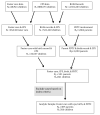How does family drug treatment court participation affect child welfare outcomes?
- PMID: 24736039
- PMCID: PMC4194264
- DOI: 10.1016/j.chiabu.2014.03.010
How does family drug treatment court participation affect child welfare outcomes?
Abstract
Parental substance use is a risk factor for child maltreatment. Family drug treatment courts (FDTCs) have emerged in the United States as a policy option to treat the underlying condition and promote family preservation. This study examines the effectiveness of FDTCs in North Carolina on child welfare outcomes. Data come from North Carolina records from child protection services, court system, and birth records. Three types of parental participation in a FDTC are considered: referral, enrolling, and completing an FDTC. The sample includes 566 children who were placed into foster care and whose parents participated in a FDTC program. Findings indicate that children of parents who were referred but did not enroll or who enrolled but did not complete had longer stays in foster care than children of completers. Reunification rates for children of completers were also higher. Outcomes for children in the referred and enrolled groups did not differ in the multivariate analyses. While effective substance use treatment services for parents may help preserve families, future research should examine factors for improving participation and completion rates as well as factors involved in scaling programs so that more families are served.
Keywords: Child welfare; Family drug treatment court; Foster care; Parental substance use.
Copyright © 2014 Elsevier Ltd. All rights reserved.
Similar articles
-
Effects of a Rural Family Drug Treatment Court Collaborative on Child Welfare Outcomes: Comparison Using Propensity Score Analysis.Child Welfare. 2015;94(4):139-59. Child Welfare. 2015. PMID: 26827480
-
Do specialty courts achieve better outcomes for children in foster care than general courts?Eval Rev. 2013 Feb;37(1):3-34. doi: 10.1177/0193841X13487536. Epub 2013 Jun 4. Eval Rev. 2013. PMID: 23737613
-
Substance abuse and serious child mistreatment: prevalence, risk, and outcome in a court sample.Child Abuse Negl. 1991;15(3):197-211. doi: 10.1016/0145-2134(91)90065-l. Child Abuse Negl. 1991. PMID: 2043972
-
The impacts of family treatment drug court on child welfare core outcomes: A meta-analysis.Child Abuse Negl. 2019 Feb;88:1-14. doi: 10.1016/j.chiabu.2018.10.014. Epub 2018 Nov 6. Child Abuse Negl. 2019. PMID: 30412783
-
Factors affecting the foster care placement decision: an analysis of national survey data.Am J Orthopsychiatry. 1991 Apr;61(2):272-81. doi: 10.1037/h0085011. Am J Orthopsychiatry. 1991. PMID: 2048642 Review.
Cited by
-
PROTOCOL: Family treatment drug courts for improving parental legal and psychosocial outcomes.Campbell Syst Rev. 2019 Aug 14;15(1-2):e1024. doi: 10.1002/cl2.1024. eCollection 2019 Jun. Campbell Syst Rev. 2019. PMID: 37131468 Free PMC article. No abstract available.
-
Strategies to Help CWS-Involved Parents Complete Substance Use Treatment and Protect their Children in Hawai'i.Hawaii J Health Soc Welf. 2022 Dec;81(12 Suppl 3):37-42. Hawaii J Health Soc Welf. 2022. PMID: 36660281 Free PMC article.
-
Drug Court as an Intervention Point to Affect the Well-Being of Families of Parents with Substance Use Disorders.Subst Use Misuse. 2020;55(7):1068-1078. doi: 10.1080/10826084.2020.1726394. Epub 2020 Feb 24. Subst Use Misuse. 2020. PMID: 32091939 Free PMC article.
-
Enhancing Permanency in Children and Families (EPIC): a child welfare intervention for parental substance abuse.BMC Public Health. 2021 Apr 23;21(1):780. doi: 10.1186/s12889-021-10668-1. BMC Public Health. 2021. PMID: 33892671 Free PMC article. Clinical Trial.
-
PROTOCOL: Psychosocial, pharmacological and legal interventions for improving the psychosocial outcomes of children with substance misusing parents.Campbell Syst Rev. 2020 Sep 2;16(3):e1113. doi: 10.1002/cl2.1113. eCollection 2020 Sep. Campbell Syst Rev. 2020. PMID: 37131914 Free PMC article.
References
-
- American University School of Public Affairs BJA Drug court technical assistance/clearinghouse project summary of drug court activity by state and county juvenile/family drug courts. 2012 Nov 30; Retrieved from http://www.american.edu.
-
- Ashford J. Treating substance-Abusing parents: A study of the Pima County family drug court approach. Juvenile and Family Court Journal. 2004;55:27–37.
-
- Bambrough S, Shaw M, Kershaw S. The Family Drug and Alcohol Court service in London: a new way of doing Care Proceedings. Journal of Social Work Practice. 2013:1–14.
-
- Barnard M, McKeganey N. The impact of parental problem drug use on children: what is the problem and what can be done to help? Addiction. 2004;99:552–559. - PubMed
-
- Barth R, Lloyd E. Five-year developmental outcomes for young children remaining in foster care, returned home, or adopted. In: Fernandez E, Barth RP, editors. How does foster care work? International evidence on outcomes. Jessica Kingsley; London, England: 2010.
Publication types
MeSH terms
Grants and funding
LinkOut - more resources
Full Text Sources
Other Literature Sources
Medical


